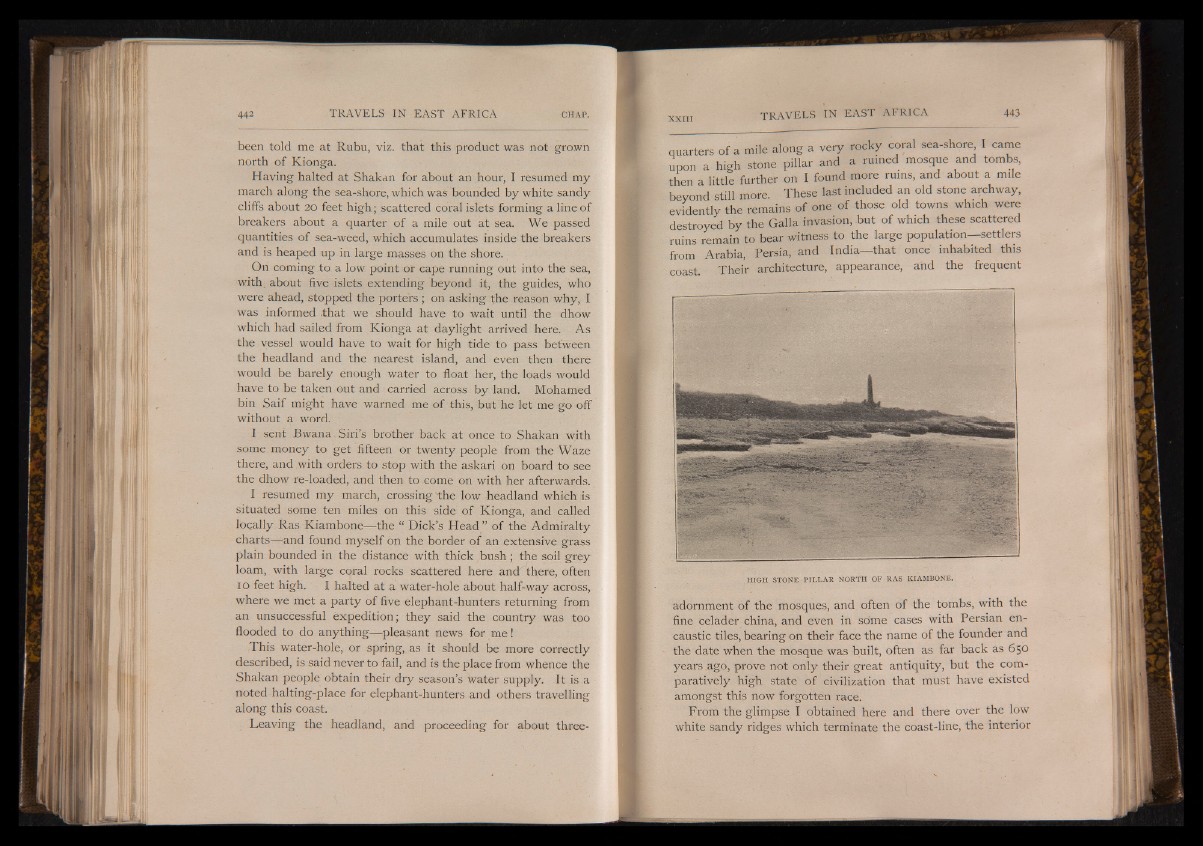
been told me at Rubu, viz. that this product was not gro.wn
north of Kionga.
Having halted at Shakan for about an hour, I resumed my
march along the sea-shore, which was bounded by white sandy
cliffs about 20 feet high; scattered coral islets forming a line of
breakers about a quarter of a mile out at sea. We passed
quantities of sea-weed, which accumulates inside the breakers
and is heaped up in large masses on the shore.
On coming to a low point or cape running out into the sea,
with, about five islets extending beyond it, the guides, who
were ahead, stopped the porters; on asking the reason why, I
was informed .that we should have to wait until the dhow
which had sailed from Kionga at daylight arrived here. As
the vessel would have to wait for high tide to pass between
the headland and the nearest island, and even then there
would be barely enough water to float her, the loads would
have to be taken out and carried across by land. Mohamed
bin Saif might have warned me of this, but he let me go off
without a word.
I sent Bwana.Siri’s brother back at once to Shakan with
some money to get fifteen or twenty people from the Waze
there, and with orders to stop with the askari on board to see
the dhow re-loaded, and then to come on with her afterwards.
I resumed my march, crossing the low headland which is
situated some ten miles on this side of Kionga, and called
logally Ras Kiambone— the “ Dick’s Head ” of the Admiralty
charts— and found myself on the border of an extensive grass
plain bounded in the distance with thick bush; the soil grey
loam, with large coral rocks scattered here and" there, often
10 feet high. I halted at a water-hole about half-way across,
where we met a party of five elephant-hunters returning from
an unsuccessful expedition; they said the country was too
flooded to do anything— pleasant news for me!
This water-hole, or spring, as it should be more correctly
described, is said never to fail, and is the place from whence the
Shakan people obtain their dry season’s water supply. It is a
noted halting-place for elephant-hunters and others travelling
along this coast.
Leaving the headland, and proceeding for about threequarters
of a mile along a very rocky coral sea-shore I came
upon a high stone pillar and a ruined mosque and tombs,
then a little further on I found more rums, and about a mile
beyond still more. These last included an old stone archway,
evidently the remains of one o f those old towns which were
destroyed by the Galla invasion, but of which these scattered
ruins remain to bear witness to the large population— settlers
from Arabia, Persia, and India— that once inhabited this
coast. Their architecture, appearance, and the frequent
HIGH STONE PILLAR NORTH OF RAS KIAMBONE.
adornment of the mosques, and often of the tombs, with the
fine celader china, and even in some cases with Persian encaustic
tiles, bearing on their face the name of the founder and
the date when the mosque was built, often as far back as 650
years ago, prove not only their great antiquity, but the comparatively
high state of civilization that must have existed
amongst this now forgotten race.
From the glimpse I obtained here and there over the low
white sandy ridges which terminate the coast-line, the interior